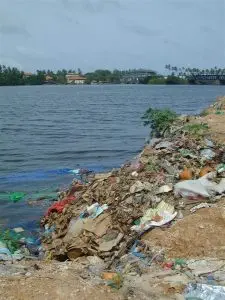The Ocean is not “Away”.
Recently the shores of Henderson Island, one of the most remote islands in the world, were found to be deep in garbage, with the equivalent of several truckloads delivered daily by incoming currents. This remote uninhabited island in the south Pacific (the nearest inhabited island is Pitcairn) received garbage from all nations surrounding the Pacific. Like the Eastern garbage patch and the Western one shown in the map below, apparently a southern patch also is present. This article draws on work in coastal zones worldwide, including thre Smithsonial article which follows. .
Ocean Trash Plaguing Our Sea
Garbage patches in the ocean aren’t piled-up islands of trash and debris, as is the common perception. But that doesn’t mean the tiny, swirling plastic bits are nothing to worry about.
In the Pacific Ocean, four ocean currents merge to form the North Pacific gyre, also known as the North Pacific Subtropical High, which spans the western US to Japan, and Hawaii to California. This enormous rotating vortex has collected floating garbage from across the Pacific, but much of the debris can typically be found in the calm center of this rotating area, often referred to as the “eastern Pacific garbage patch.” Keep in mind, however, that this is no island or blanket of trash that can be seen with satellite or aerial photographs—most of the floating trash is tiny pieces of plastic, many of them so small as to be invisible to the human eye.
Its vast size and the small size of the trash left the garbage patch largely unnoticed until the early 1990s, when Captain Charles Moore, head of the Algalita Marine Research Foundation, sailed through a rarely traveled area between Hawaii and the mainland. Over the course of a week, despite being hundreds of miles from land, Moore watched a continuous stream of plastic trash float by. Although fishermen and sailors have noted the debris in this area for years, it was Captain Moore who brought the area into the public sphere.
While the garbage patch has received a lot of attention because of its size, it is not the only area where marine debris can be found: marine debris affects waters and coastlines around the world. A 2014 study estimated that 8 million metric tons of plastic trash enter the sea from land every year—the equivalent of five plastic bags filled with trash for every foot of coastline around the world. Animals frequently become entangled in large pieces of debris, and can be cut, drowned, or slowed down by dragging the extra weight. Additionally, heavy gear, such as fishing nets, can damage reefs and other important habitats.
Because of its durability, low cost, and our increased use in recent decades, plastic makes up the majority of marine debris seen on shorelines and floating in oceans worldwide. This creates a difficult problem because most plastics are not biodegradable (bacteria don’t break them down into simple, harmless components the way they do paper or wood). Instead, as plastic ages, the sun’s light and heat break it into smaller and smaller pieces.
This tiny plastic confetti, along with larger pieces of floating plastic, creates a big problem. Birds and filter feeders that strain food out of the water may mistake plastic for plankton, fish eggs, or other food. On remote Midway Atoll, Laysan albatross parents accidentally feed their chicks bits of plastic, which fill up their stomachs and cause them to starve. Deep-sea fish living near the garbage patch eat the tiny bits of plastic. Scientists have discovered that microbial ecosystems grow on the floating plastic bits, to unknown effect. Even in the protected waters of the Papahānaumokuākea Marine National Monument along the northwestern Hawaiian Islands, our trash threatens endangered species like Hawaiian monk seals and green sea turtles.
This massive global problem is not hopeless. Some countries and states have banned plastic bags, a trend that will continue with public support. Participating in beach or park clean-ups is an easy way to reduce the amount of trash that reaches natural waters. You can avoid exfoliating soaps and toothpastes with tiny plastic microbeads, and complain to the companies that make them. And you can help every day by avoiding plastic packaging wherever possible, bringing reusable bags to the grocery store, and drinking from reuseable water bottles or coffee mugs.
Scientists with agencies such as NOAA, and other institutions around the world, continue to research the impacts of marine debris, including the emerging area of microplastic debris (plastic that is less than 5mm) and its impacts on our marine ecosystems.
Last Updated May 31, 2015



 These pictures are from three different continents.
These pictures are from three different continents.
Leave a Reply